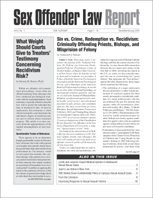Effects of Registration and Notification on Offenders and the Community
Author: Sarah C. Solomon.; Jeff Lee.; John Stuart Batchelder.
Source: Volume 08, Number 05, August/September 2007 , pp.65-69(5)

next article > |return to table of contents
Abstract:
Identifying sex offenders was not a part of the U.S. criminal justice system until the 1940s, when Arizona and California became the first states to initiate sex offender registries. (A.R. Bedarf, “Examining Sex Offender Community Notification Laws,” 83 California L. Rev. 885 (2005).) As early as the 1950s, inspired by increased awareness of sexual offending, politicians began discussing the possibility of requiring all released sex offenders to register with local police departments. With time, the discussion turned to public access of those registries. However, prior to 1994 there was no clear way for members of a community to recognize or identify specific individuals as previously convicted sexual offenders. Today, every state in the nation has a statuteproviding for a sex offender registry, and many states grant public access to those registries. (J.J. Herman, “N ot in My Community: Is It Legal for Private Entities to Ban Sex Offenders From Living in Their Communities? ,” 16 (1) Widener L. J. 165-92 (2006).))Keywords:
Affiliations:
1: Troy University; 2: Troy University; 3: North Georgia College & State University.